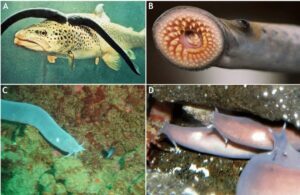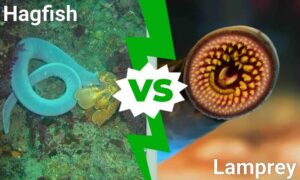Back to: ZOOLOGY 300 Level
WELCOME TO CLASS!
It’s always great to have you here! You’re doing something powerful by deepening your understanding of animals that many people have never even heard of. Today, we’re turning our attention to two unusual but important creatures in vertebrate history: hagfishes and lampreys
Hagfishes And Lampreys.
These animals may not be the stars of wildlife documentaries like lions or elephants, but they are very special because they help us understand what the earliest vertebrates looked like and how more complex ones came to be. Let’s dig in and see why scientists and zoologists care so much about them.

Who Are Hagfishes and Lampreys?
Hagfishes and lampreys are jawless fish, also called agnathans. That means they don’t have proper jaws like the catfish in River Niger or the tilapia in Lagos markets. Instead, they have primitive structures for feeding.
They are among the most ancient living vertebrates, which makes them like time machines—offering clues about what vertebrates looked like hundreds of millions of years ago.
Hagfishes: The Slime Masters
Let’s start with the hagfish. This strange creature lives in deep ocean waters and looks like a long, slimy eel. But it’s not an eel at all. Hagfishes have no jaws, no bones, and even no vertebrae in the traditional sense—though they do have a skull. Because of this, some scientists call them craniates instead of full vertebrates.
One thing hagfishes are famous for is their slime. When attacked, they release large amounts of slippery mucus from their skin—enough to choke a predator. Imagine a pot of ogbono soup poured into the ocean—very slimy and very hard to catch! This slime helps them escape danger and even clog the gills of predators like sharks.

They also feed in a rather unusual way—by boring into dead animals and eating them from the inside. They use a toothed, tongue-like structure to rasp flesh. Not pretty, but very effective.
Lampreys: The Jawless Parasites
Now meet the lamprey. These creatures look similar to hagfishes, but they’re more closely related to vertebrates as they have cartilaginous vertebrae. They also have a dorsal nerve cord, notochord, and a proper vertebral column, making them more advanced than hagfishes.
Lampreys live in both freshwater and marine environments, including some rivers in Africa. They are known for their sucker-like mouth, lined with rows of keratin teeth. They attach to other fish and suck their blood—which makes them parasites.
Lampreys have seven gill slits on each side of their body, two small eyes, and a single nostril on the top of their head. They are powerful swimmers and can migrate from saltwater to freshwater to spawn.
Why They Matter in Zoology
Hagfishes and lampreys are important because they help scientists understand early vertebrate evolution. They show us what life was like before jaws evolved, and they give us clues about how complex organs, nervous systems, and vertebrae developed.

For example, lampreys have a simple brain, light-sensitive eyes, and a basic circulatory system—showing us how more advanced systems in mammals and birds may have started.
Summary
- Hagfishes and lampreys are jawless fish and among the most primitive vertebrates.
- Hagfishes live in deep oceans, produce slime, and feed on dead animals.
- Lampreys have simple vertebrae and are parasites that feed on the blood of other fish.
- These animals give scientists insights into how modern vertebrates evolved from simpler ancestors.
Evaluation
- What makes hagfishes different from other vertebrates?
- How do lampreys feed, and what makes them parasitic?
- Mention two reasons why scientists study hagfishes and lampreys.
- How does the slime of hagfish help it survive?
- Do lampreys have jaws? Explain your answer.
You’ve just learnt about some of the oldest and most unusual members of the vertebrate family. They may not be cute or cuddly, but they’re full of secrets about where we all came from. Keep that passion for knowledge alive—we have more amazing topics just around the corner!
